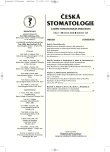-
Medical journals
- Career
Dental Treatment in Children under General Anaesthesia
Authors: R. Ivančaková 1; V. Růžička 1; Z. Řeháčková 2
Authors‘ workplace: Stomatologická klinika LF UK a FN, Hradec Králové přednosta doc. MUDr. P. Slezák, CSc. 1; Klinika anestezie, resuscitace a intenzivní medicíny LF UK a FN, Hradec Králové přednosta doc. MUDr. V. Černý, Ph. D, FCCM 2
Published in: Česká stomatologie / Praktické zubní lékařství, ročník 108, 2008, 1, s. 8-12
Category:
Overview
The caries experience of pre-school children has been increasing over the last years. The defects of primary teeth are often so extensive that multiple extractions are necessary. Most of these patients are unable to cooperate due to low age and extend of the treatment. Dental treatment under general anaesthesia is then the method of choice. The aim of this paper is to present our results and experiences of treatment of children in general anaesthesia. The total number of 185 patients (110 boys, 75 girls) aged 6 month to 16 years has been treated within the period from 1.1. 2004 till 31.12. 2006. 1414 teeth have been treated, from which 1292 (91,3%) deciduous and 122 (8,7%) permanent. The most frequent type of treatment was extractions (1174), mainly of primary teeth (1109), and restorations (240). More than half of the treated deciduous teeth were the first and second molars (58,7%), followed by upper incisors (28,8%) and then other teeth, less then 10%. The authors did not record any complication in the course of treatment and immediately afterwards, requiring unplanned hospitalisation of the outpatient and unfavourably affecting the health status of the child. There was no negative experience in children after the treatment in general anaesthesia, which would result in subsequent refuse of dental care.
Key words:
dental treatment – children – general anaesthesia
Sources
1. Lenčová, E., Broukal, Z., Mrklas, L.: Caries involvement of upper deciduous incisors in 5-yr olds; an attempt of epidemiological definition of early childhood caries. Caries Res., 36, 2002, s. 204.
2. Broukal, Z., Bártová, L.: Kazivost a stav dočasného chrupu dětí ve věku 2-3 roky v Praze a preventivní postoje a chování rodičů. Čes. Stomat., 101, 2001, 1, s. 25-32.
3. Stecksén-Blicks, C., Sunnegardh, K., Borssen, E.: Caries experience and background factors in 4-year-old children: time trends 1967-2002. Caries Res., 38, 2004, s. 149-155.
4. Pantuček L.: Nespolupracující pacienti v dětském zubním lékařství. Prakt. zub. Lék., 2006, 54, 1, s. 16-22.
5. Semrádová V.: Příčiny nespolupráce či zhoršené spolupráce dětí při stomatologickém ošetření. Čs. Stomat., 82, 1982, 2, s. 145-148.
6. Day, P. F., Power, A. M., Hibbert, S. A. et al.: Effectiveness of oral midazolam for paediatric dental care. Eur Arch. Paediatr Dent., 7, 2006, 4, s. 228-235.
7. Nathan, J. E.: Behavioral management strategies for young pediatric dental patients with disabilities. J. of Dentistry for Childrenm, 2001, s. 89-101.
8. Coulthard, P.: Conscious sedation guidance. Evid Based Dent., 7, 2006, 4, s. 90-91.
9. American Academy of Pediatric Dentistry. Guidelines for the effective use of conscious sedation, deep sedation and general anesthesia in pediatric dental patients. Pediatr. Dent., 27, 2005-2006, (7 Reference Manual), s. 119-121.
10. Haubek, D., Fuglsang, M., Poulsen, S. et al.: Dental treatment of children referred to general anaesthesia. Int. J. Paediatr Dent., 16, 2006, 4, s. 239-246.
11. Clewett, J. A., Treasure, E. T.: A retrospective study of dental general anesthesia carried out in children living in North Wales 1995-1998. Community Dent Health,. 21, 2004, 3, s. 212-216.
12. Albadri, S. S., Lee, S., Lee, G. T. et al.: The use of general anaesthesia for the extraction of children´s teeth. Eur. Arch. Paediatr. Dent., 7, 2006, 2, s. 110-115.
13. Welbury, R. R., Duggal, M. S., Hosey, M. T.: Paediatric dentistry. 3 rd edition. Oxford Medical Publications, New York, 2005, s. 63-88.
14. Gibson, S., Williams, S.: Dental caries in pre-school children. Caries Res., 33, 1999, 2, s. 101-113.
Labels
Maxillofacial surgery Orthodontics Dental medicine
Article was published inCzech Dental Journal

2008 Issue 1-
All articles in this issue
- Blockade of Nervus Alveolaris Inferior in 284 Patients with Semi-retained and Retained Lower Wisdom Teeth: Our Experience
- Oral Mucositis as a Side Effect of Myeloablative Chemotherapy in Hemato-oncological Patients
- The Contribution to the Study of Dentition State of the Brno Population in the 2nd Half of 18th Century and in the 19th Century
- Free Radicals and Antioxidants in Stomatology
- Temporomandibular Point and Its 2D and 3D Models
- Dental Treatment in Children under General Anaesthesia
- Czech Dental Journal
- Journal archive
- Current issue
- Online only
- About the journal
Most read in this issue- Temporomandibular Point and Its 2D and 3D Models
- Dental Treatment in Children under General Anaesthesia
- Blockade of Nervus Alveolaris Inferior in 284 Patients with Semi-retained and Retained Lower Wisdom Teeth: Our Experience
- Oral Mucositis as a Side Effect of Myeloablative Chemotherapy in Hemato-oncological Patients
Login#ADS_BOTTOM_SCRIPTS#Forgotten passwordEnter the email address that you registered with. We will send you instructions on how to set a new password.
- Career

